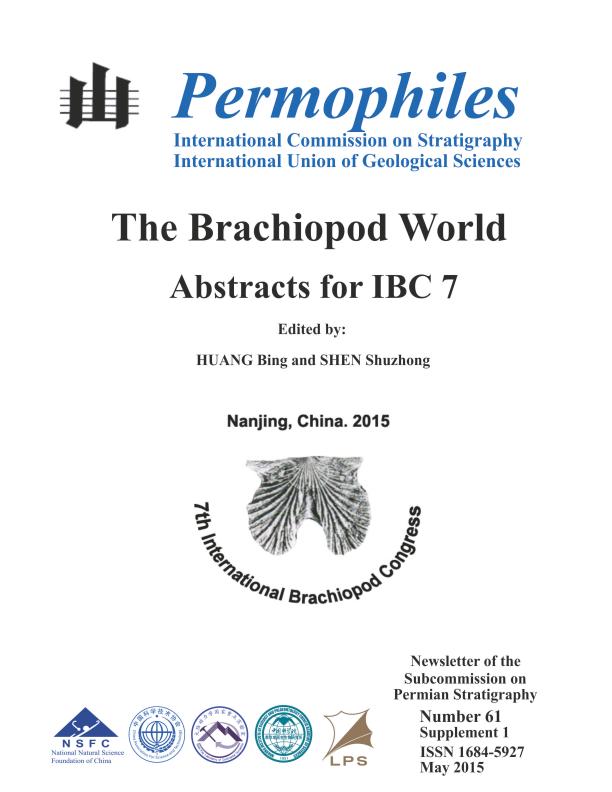Mostrar el registro sencillo del ítem
dc.contributor.author
Siccardi, Aron

dc.contributor.other
Huang, Bing
dc.contributor.other
Shen, Shuzhong
dc.date.available
2024-02-06T13:29:27Z
dc.date.issued
2015
dc.identifier.citation
A revisited Silurian-Lower Devonian brachiopod biostratigraphy of North Patagonian Massif, Ventania system and Southern Paraná Basin. A regional correlation; 7th International Brachiopod Congress; Nanjing; China; 2015; 79-81
dc.identifier.issn
1684-5927
dc.identifier.uri
http://hdl.handle.net/11336/225919
dc.description.abstract
The fist collections of Silurian-Devonian brachiopods fromSouth America were realized by Charles Darwin (1833) inthe Malvinas Islands, during his voyage on the H.M.S. Beaglearound the world and they were lately described by Morris andSharpe (1846). After that Clarke?s monograph (1913) provided anapproach on systematics and paleobiogeography of this fauna.Contemporary works were mainly focused in the Proto-Andeanmargin but the Silurian-Devonian faunas from the Atlanticoutcrops (Fig. 1) especially those of North Patagonian Massif(Müller, 1965), Ventania (Andreis, 1964), Eastern Paraguay(Harrington, 1950; Wolfart, 1961) and Uruguay (Méndez-Alzola,1938), remained poorly studied.The Silurian brachiopods reviewed come from Sierra GrandeFormation (Northern Patagonia) and Vargas Peña Formation(Eastern Paraguay, Parana Basin). This two sections bearingiron levels, ranging from iron coating to oolitic ironstones. Fromthe Sierra Grande Formation two oolitic iron levels are recognised; below the fist iron level it is found the fauna described asHeterorthella freitana-Clarkeia antisiensis (Müller, 1965); belowthe second iron level, the suggested presence of Conularia quichua-Bainella sp hinted a Lower Devonian age. However, recentstudies (Siccardi et al. 2014), allowed recognized the Llandoverianbrachiopods Eostropheondonta chilcaensis (BENEDETTO,1995), Heterorthella? sp, Dalmanella? sp, Hindella? sp. andRessellerids (Resserella?, Vysbiella?). In addition, a trilobite assemblage dominated by Eoleonaspis sp, supports theLlandoverian age (Rustán et al. 2013). The Vargas Peña Formationis included in the siliciclastic sequence of the Itacurubí Group(Hirnantian-Lower Silurian) and its brachiopod faunas knownfrom are composed by Anabaia paraguayensis (HARRINGTON,1950), accompanied of scarce inarticulates (Obolidae? indet.);the age assigned to this assemblage is Aeronian to late Telychian(Tortello et al. 2012 and references therein). Even though, in theParaguayan outcrops oolitic ironstones have not been found, theyare mentioned in subsurface drills.Fig.1. Outcrop location. (A) Eastern Paraguay. (B) Uruguay (DuraznoDepartment). (C) Sierra de la Ventana. (D) Sierra Grande.The Lower Devonian brachiopod faunas that integrate thisstudy have been collected from outcrops of the Lolén Formation(Sierra de la Ventana) and the Cordobés Formation (Uruguay,Durazno Department). In the base of the Lolén unit, the uppermostin the Ventana Group (Silurian?-Middle Devonian), an assemblage composed by Cryptonella sp, Schellwienella sp, Leptocoeliasp and Derbyia sp was originally mentioned by Andreis (1964)Following contributions (Isaacson, 1975, 1991), have also mentioned the presence of Proboscidina arcei ISAACSON, 1977. Thefauna of the Lolen Formation is characterized by the low diversity and the strong deformation. However, the new collection fromthe recent fild works has allowed to confim the presence of thetaxon previously described, as well as to identify the brachiopodsMutationelidae? indet, Orbiculoidea? sp, and Pleurothyrella?sp.,accompanied by the bivalves Nuculites sp. The age suggestedfor this brachiopod assemblage is Lochkovian-Pragian (SuarezSoruco, 2000). Devonian brachiopods from Uruguay registeredin the Cordobés Formation (Durazno Group) are more diversifidand associated to the Cordobés Formation, a dominantly shalysequence. An Emsian faunal assemblage, dominated by the brachiopods Australocoelia palmata (MORRIS AND SHARPE,1846) and Orbiculoidea bainii? SHARPE, 1856, accompaniedby the less abundant Derbyina? sp., Pleurochonetes falklandicus (MORRIS AND SHARPE, 1846), Iridistrophia? sp. andGigadiscina collis (CLARKE,1913) has been herein recognized.The mixed dominance could be explained due to the overlap of theOrbiculoidea and Australocoelia communities.According to the available data the Silurian correlationswith others South American basins could be based on keyfaunal assemblages and sedimentary events: oolitic ironstonesin the Proto-Andean margin and the glacial event in the Northeastern Brazil. The presences of oolitic ironstones between thefaunas considered would provide an additional correlation tool.The oolitic ironstones are well-known from the Proto- Andeanmargin and having a biostratigraphical control. The oldest agesdefied are Late Rhuddanian and the youngest, Late Telychian.When considering the hypothesis of the ironstones deposition andthe glaciation events (Caputo, 1998), they could be traced as aresponse of interglacial early transgressive stages, during the lastpulse of the Early Palaeozoic Glacial event. In the Sierra GrandeFormation the Eostropheondonta and Ressellerids associationdominate the brachiopod assemblage having an Ordovician mark,plus the absence of Ordovician key genera indicate a (Lower?)Rhuddanian age. Wenlockian faunas have not been registered inthe studied sections. The correlations proposed are schematisedin Fig.2.Within the Lower Devonian interval, three key species couldbe recognised: Proboscidina arcei, Scaphiocoelia boliviensisWHITFIELD, 1890 and Australocoelia palmata. The fist one,apart from being founded in Sierra de la Ventana, it is abundantduring Lochkovian-Pragian times in several Bolivian localitiesand South Africa (Uppermost Nardouw Subgroup, BaviaanskloofFormation. Meanwhile Scaphiocoelia is traditionally proposed asa Pragian key genus, but it restricted to Bolivia and South Africaand records from others basins (Brazil and Precordillera) are confusing. During the Emsian stage, Australocoelia palmata becamea common (and dominant) component of most of the shallowwater brachiopod assemblages.
dc.format
application/pdf
dc.language.iso
eng
dc.publisher
International Comission on Stratigraphy. International Union of Geological Sciences
dc.rights
info:eu-repo/semantics/openAccess
dc.rights.uri
https://creativecommons.org/licenses/by-nc-sa/2.5/ar/
dc.subject
BRACHIOPODS
dc.subject
SILURIAN
dc.subject
DEVONIAN
dc.subject
BIOSTRATIGRAPHY
dc.subject.classification
Paleontología

dc.subject.classification
Ciencias de la Tierra y relacionadas con el Medio Ambiente

dc.subject.classification
CIENCIAS NATURALES Y EXACTAS

dc.title
A revisited Silurian-Lower Devonian brachiopod biostratigraphy of North Patagonian Massif, Ventania system and Southern Paraná Basin. A regional correlation
dc.type
info:eu-repo/semantics/publishedVersion
dc.type
info:eu-repo/semantics/conferenceObject
dc.type
info:ar-repo/semantics/documento de conferencia
dc.date.updated
2023-08-14T11:35:25Z
dc.journal.pagination
79-81
dc.journal.pais
China

dc.journal.ciudad
Nanjing
dc.description.fil
Fil: Siccardi, Aron. Consejo Nacional de Investigaciones Científicas y Técnicas. Centro Científico Tecnológico Conicet - La Plata. Centro de Investigaciones Geológicas. Universidad Nacional de La Plata. Facultad de Ciencias Naturales y Museo. Centro de Investigaciones Geológicas; Argentina
dc.relation.alternativeid
info:eu-repo/semantics/altIdentifier/url/https://permian.stratigraphy.org/files/permophiles/20150525214216969.pdf
dc.conicet.rol
Autor

dc.coverage
Internacional
dc.type.subtype
Congreso
dc.description.nombreEvento
7th International Brachiopod Congress
dc.date.evento
2015-05-23
dc.description.ciudadEvento
Nanjing
dc.description.paisEvento
China

dc.type.publicacion
Journal
dc.description.institucionOrganizadora
The Nanjing Institute of Geology and Palaeontology
dc.description.institucionOrganizadora
Chinese Academy of Sciences
dc.source.revista
Permophiles
dc.date.eventoHasta
2015-05-25
dc.type
Congreso
Archivos asociados
